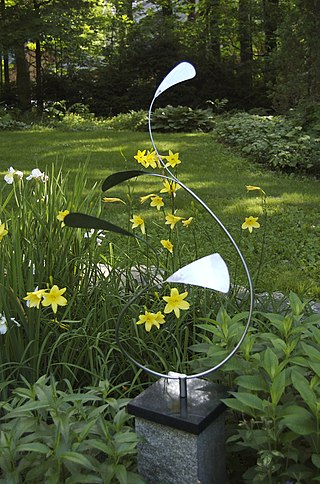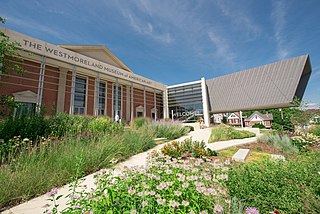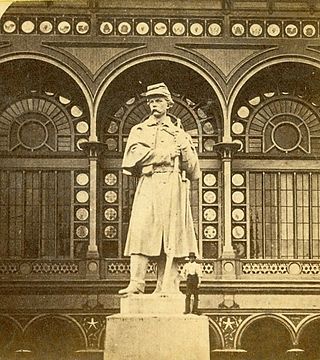Related Research Articles
Juan Downey was a Chilean artist who was a pioneer in the fields of video art and interactive art.

George Warren Rickey was an American kinetic sculptor.

David Vincent Hayes was an American sculptor.

Carol Bove is an American artist based in New York City. She lives and works in Brooklyn.
Philip Grausman is an American sculptor who continues to push the limits of the time-honored portrait in art.

Chauncey Bradley Ives was an American sculptor who worked primarily in the Neo-classic style. His best known works are the marble statues of Jonathan Trumbull and Roger Sherman enshrined in the National Statuary Hall Collection.
David Hilliard is an American photographer. A fine arts photographer who works mainly with panoramic photographs, he draws inspiration from his personal life and those around him for his subject matter. Many of the scenes are staged, evoking a performative quality, a middle ground between fact and fiction.

George Sherwood is an American kinetic and environmental sculptor.

The Westmoreland Museum of American Art is an art museum in Greensburg, Pennsylvania devoted to American art, with a particular concentration on the art of southwestern Pennsylvania.

Paul Housberg is an American glass artist recognized for his use of fused and kiln formed glass as an architectural medium. He currently resides in Jamestown, Rhode Island.
Lewis Greenleaf Adams, AIA, (1897–1977), was an American architect based in New York City who practiced in mid- to late-twentieth-century New York, New Jersey, and Connecticut, as part of the firms Malmfeldt, Adams & Prentice, Adams & Prentice, Malmfeldt, Adams & Woodbridge, Adams & Woodbridge, and under his own name at the end of his life, always based in New York City.

Elbert Weinberg was an American sculptor.
Electros Vekris, also known as Babis Vekris, is a Greek-born American artist renowned for incorporating LEDs that move in rhythmic motion and in sequence into his sculptures, installation art, and other artwork. He adopted the name Electros professionally in 1990.

Carl H. Conrads was an American sculptor best known for his work on Civil War monuments and his two works in the National Statuary Hall Collection at the U.S. Capitol in Washington, D.C. He was also known as Charles Conrads.

Robert Perless is an American artist whose particular focus is kinetic art sculptures.
Carroll Dunham is an American painter. Working since the late 1970s, Dunham's career reached critical renown in the 1980s when he first exhibited with Baskerville + Watson, a decade during which many artists returned to painting. He is known for his conceptual approach to painting and drawing and his interest in exploring the relationship between abstraction and figuration.

Mary Miss is an American artist and designer. Her work has crossed boundaries between architecture, landscape architecture, engineering and urban design. Her installations are collaborative in nature: she has worked with scientists, historians, designers, and public administrators. She is primarily interested in how to engage the public in decoding their surrounding environment.
Jean-Jacques Duval was a French-born American artist who pioneered abstract art and the use of faceted glass in stained glass design in the 1960s. In 2005 he was awarded the Lifetime Achievement Award by the Stained Glass Association of America. Best known for his window designs in Germany, Israel, Japan, the West Indies, and the United States, his paintings and sculptures have also been exhibited throughout North America.

David C. Roy is a kinetic sculptor. He has designed over 150 different moving sculptures and produced one-of-a-kind or limited edition instances of each: In total he has hand-built thousands of pieces.

Irwin Rubin was an American artist and educator known for his colorfully painted wood constructions.
References
- ↑ "Tim Prentice," September 27, 1987, Hartford Courant.
- ↑ Pete Davies (March 12, 2010). "11 Times Square Flaunts Phantom Tenants". New York Curbed . Retrieved 16 August 2016.
- ↑ "See Flashdance by Tim Prentice at Jacksonville International Airport, Jacksonville". www.wescover.com. Retrieved 2018-05-12.
- ↑ Thomas, M. (18 October 2015). "Westmoreland Museum of American Art spreads its wings". Pittsburgh Post-Gazette. Retrieved 15 August 2016.